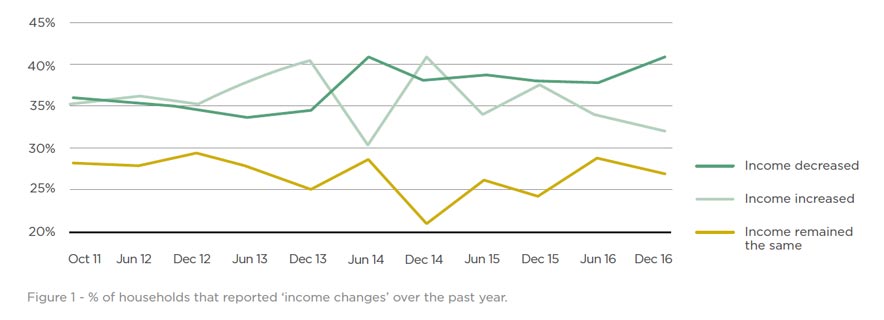Income cuts, record-high job insecurity and high rates of underemployment are putting stress on households’ financial comfort, according to ME’s latest Household Financial Comfort Report.
The Report shows a marked long-term deterioration in Australian households’ ‘comfort with income’, which remains at its lowest level since the Report began in 2011, at 5.55 out of 10.
Record low income gains highlight widening gap between rich and poor
ME consulting economist and Report co-author, Jeff Oughton, said the reasons for income worries were clear.
“Only 32% of households reported ‘income gains’ over the past year – one of the lowest levels since the first survey in 2011 and down from the corresponding figure of 38% 12 months ago,” said Oughton.
Oughton said income gains were more likely to be reported by those with higher incomes and wealthier Australians.
Almost one in two (or 46%) of households with incomes over $100,000 reported ‘income gains’, compared to 17% of households earning under $40,000. Conversely, 41% of households earning less than $40,000 reported income losses, compared to only 13% of those earning over $100,000.
“The rich appear to be getting richer, while the rest of Australia is struggling – there’s a divide across households,” said Oughton.
Households earning an annual income above $200,000 reported very high overall financial comfort of 7.10 out of 10 in December, compared with ME’s overall household financial comfort index (5.41 out of 10).
“We’re seeing a shift in the composition of jobs as the economy moves away from mining and manufacturing with many employees leaving longer-term jobs and taking up lower-paying less-permanent jobs, which is having a negative impact on their financial comfort,” said Oughton.
“ABS data shows wage growth at historical lows over the past two years to the September quarter. ME’s Report supports this, highlighting low wage growth continued in the whole of 2016 and is causing financial discomfort for many households, exacerbated by job insecurity and underemployment.”
Job insecurity and underemploymentIn addition to income cuts, high levels of underemployment and record high ‘job insecurity’ were also contributing to households’ historically low comfort with income.
“One in three Australian households (34%) reported ‘job insecurity’ – a record high and an increase of 9 points over the year to December 2016,” said Oughton.
“Furthermore, 56% of households felt that they would ‘struggle to find a new job within two months if they became unemployed’, an increase of 3 points over the past year, while only 37% said it would be ‘easy to find a job’, down 3 points in the past 12 months.”
“Despite Australia’s relatively low official unemployment rate of 5.8% in December 2016, ME’s Report shows 60% of part-time employees would like to ‘increase the hours they work’ and 70% of casual workers want to ‘change from casual to permanent employment’,” said Oughton.
Tighter purse stringsThe proportion of households saving increased 3 points to 51%, with these households saving an extra $58 each month on average.
“Arguably reflecting tougher labour market conditions outweighing the impact of rising (net) wealth, households tightened their purse strings over the six months to December, saving more where they could and overspending less.
“It’s an increased conservatism that will be contributing to a drag on growth as Australia’s economic transition continues,” said Oughton.
Meanwhile, those households ‘spending more than they earn each month’ (9% of households) also cut back, reducing their overspending by an average of $55 less each month. Consistent with these findings, overall household comfort with cash savings rose by 3% to 4.94 out of 10 in the latest Report.
Other findings:‘Single parents’ doing it the toughest: ‘Single parents’ reported the lowest levels of financial comfort the Report has seen (4.34 out of 10) – a 3% decrease in the six months to December 2016.
‘Gen X’ down in the dumps: ‘Gen X’s’ financial comfort decreased by 5% to the lowest level on record (4.92 out of 10), reflecting lower comfort across all key drivers with the biggest falls in comfort around debt (down 8% to 5.21) and incomes (down 6% to 5.19).
‘Retirees’’ financial comfort on the up: ‘Retirees’’ household financial comfort rose by 8% to 6.23 out of 10. Likely due to current majority of retirees not being faced with pending superannuation and pension changes, and having ridden the continued wave of growth in the property market and renewed strength in equity markets. Retirees’ ‘comfort with both their investments and wealth’ rose by 11% in the last six months, and their ‘ability to cope with a financial emergency’ is the highest of all household cohorts.
WA rebounds, at least temporarily: Financial comfort in WA increased by 6% to 5.34 out of 10, reversing the record low results seen in the previous Report (5.02 out of 10). Many key drivers of financial comfort rose, with double-digit gains in ‘investments’ and ‘cash savings’.
South Australians feeling the pinch: South Australians experienced an 8% decrease in financial comfort during the six months to December 2016. Many key drivers of financial comfort fell, with recent adverse weather and energy disruptions potentially weighing, at least temporarily, negatively on household comfort.

